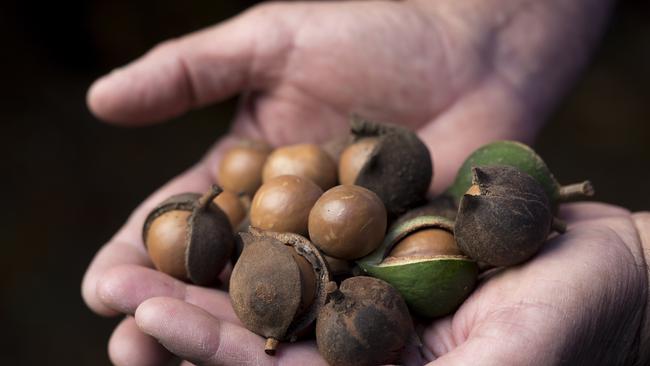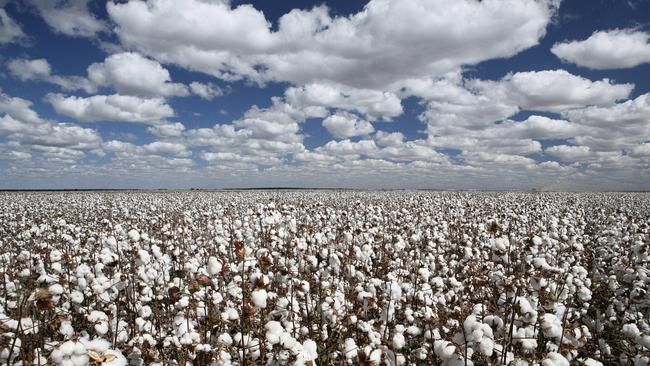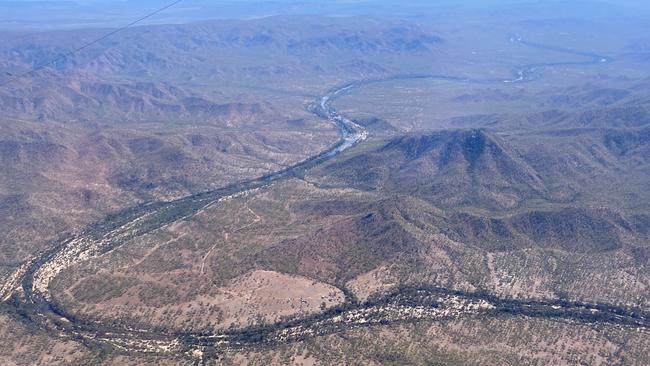Urannah Dam promises new life for Collinsville and Bowen
After 60 years of promises, residents believe a major Queensland dam project might come through this time and usher in a new age of agricultural prosperity and hundreds of jobs. See the drone footage.
News
Don't miss out on the headlines from News. Followed categories will be added to My News.
Proponents of the massive $2.9bn Urannah Dam project say it could usher in fields of macadamia nuts and citrus crops while also arresting the decline of the region’s boom-and-bust mining towns.
The transformative aspirations of the project has residents excited, even those in businesses disconnected from the project’s link to mining, energy and agriculture.
Ross Meier runs the Murroona Gardens nursing home in Bowen and says the project could help staunch the outflow of young people from the towns he loves.
“Collinsville itself, it’s an old mining town, based on coal,” he said.
“With resources, it’s a fly-in fly-out and drive-in drive-out arrangement.
“Those contributing to the community, that number has declined.
“If there is anything we can do to slow down the exodus of our school leavers from our region and keep them here in our community, that would be wonderful.”

He says more agricultural development and the follow-on increase in local employment could help lift Collinsville out of its boom-bust persona.
“It’s an old saying, ‘where water flows, food grows,’” he said.
“We move between feast and famine and if we can take out those peaks and troughs a little bit, that would be great.”
The project is divided into three components: a 970-gigalitre dam on the Broken River 80km west of Mackay, an irrigation scheme to implant a new farming precinct around Collinsville and a pumped-hydro scheme.
Bowen Gumlu Growers Association General Manager Ry Collins said the irrigation scheme could result in new high-value crops such as citrus and macadamias emerging to complement the region’s existing horticultural industry.
He also said new broadacre crops such as soy beans, cotton and legumes could also emerge with the scheme.

With a saturated domestic market, Mr Collins said the scheme’s participants would likely gear their operations toward export.
“It’s got to have a strong focus on customers, and that’s really export at this stage.”
He said more infrastructure and an enhanced local supply chain would be needed to facilitate export growth and this in turn would benefit all farmers in the region.
“Having that additional capacity and capability is going to benefit existing farmers as well,” he said.
The cost of the dam alone is pegged at $1.04bn and Bowen River Utilities, the proponent driving the project through the feasibility and EIS stages, wants $483m from the federal government to help build out its dreams.
Managing Director John Cotter is confident the project’s components are attractive enough for private finance to carry the bulk of the load.
“We’ve made a dam not only an economic project but also a financiable project and that is very rare to get,” he said.

He said ESG investors were particularly attracted to the irrigation scheme and pumped-hydro elements.
“It’s a large-scale ESG investment for these funds, not only growing high-value food, but they want to participate in carbon offsets, vegetation offsets and most importantly Great Barrier Reef nutrient work,” he said.
“An overseas renewable energy fund, one of the largest in the world, wants to invest 100 per cent of the capital required for the pumped hydro.”
Mr Cotter said the experience of the Fairbairn Dam as a catalyst for growth around the Central Highlands offered some justification for the cost of Urannah.
“In Emerald, that water has provided a range of secondary industries to survive those commodity supercycles,” he said.
“And a lot of those benefits are very hard to quantify and are not accepted generally by regulators.
“The population doesn’t pack up and move every time the coal gets below 100 bucks a tonne.
“That’s the same thing we’re applying in Urannah.
“Let’s put 2000 hectares of macadamias in.
“That alone is probably about 100-150 jobs during packing season.
“That puts a packing shed in Collinsville, it puts a plastic supply for the bags, it helps the refrigeration guy, he’s got more work.”

Bowen River Utilities has approached more than 150 investors globally, some of whom have expressed interest in the whole enterprise and others in specific components of the project.
“Some say ‘yeah we’d like the lot, some say no we just want bits’, and so we’ve structured it to allow that to come through,” Mr Cotter said.
Mr Cotter also said the dam asset would remain in the control of Queenslanders.
“The whole asset, the dam asset, is handed over to Sunwater half way through its life,” he said.
“This is about finding ways to fund infrastructure for the community, but ultimately it winds up in the community’s hands.
“The water will always remain in the hands of the people of Queensland.
“We’re just putting it to use in a way that can attract capital to keep that community going for the next 100 years.”
Mr Cotter said locals largely supported the massive enterprise and he claimed more than 30,000 residents had signed a petition registering their support for Urannah.
“When people say ‘water is life’, it really means something to people up here,” he said.

Some, however, are not sold on the project and have raised concerns about its claims, costs and environmental impact.
Whitsunday Conservation Council spokesman Tony Fontes said a proposal to pipe water from Urannah Dam to Peter Faust Dam west of Proserpine to ‘droughtproof’ the Whitsundays would be a burden on ratepayers.
“We don’t know what the final cost of water pumped from the proposed Urannah Dam to Peter Faust Dam will be for residents, but you can be sure that a big increase in water costs will be a burden many Whitsunday residents can’t afford,” he said.
The environmental group has called on Whitsundays Mayor, Dawson LNP candidate and Urannah supporter Andrew Willcox to detail the cost of providing water from Urannah to Whitsunday farmers and residents.
The group has also called for clarification on whether there is any intention to build the pipeline at all.
“We understand Bowen River Utilities, the company managing the Urannah project, is doubtful about the economic feasibility of building the pipeline,” Mr Fontes said.
“That is probably why they have asked the federal government to hand over another $480 million in taxpayer funds to subsidise their proposed dam.
“It is clear that the economics of this project are very doubtful.”

Mr Willcox said a decision on a pipeline running from Urannah to Peter Faust had not yet been made, but building the dam was a necessary first step to ensure water security for the region.
“You have to have the dam first and then we could potentially build that pipeline across, which then gives us access to a different catchment,” he said.
“As the Whitsunday grows, we can then use that water.
“I just don’t understand why the Whitsunday Conservation Council is so against mining and farming.”
Mr Willcox said the project “stacked up” and could help Australia “feed the world”.
“We could introduce new crops like macadamias, avocado and mangoes,” he said.
“Australia has beautiful fertile soil and a fantastic climate, so our job should be to feed the world.
“But the first stage of all of this is to actually build the dam.”
Collinsville resident Sue Clarke runs Collinsville Connect, a support hub for the town.
She hopes to see the dam built after 60 years of talk.
“We’ve been hearing about the project for a very long time,” she said.
“Anything that increases the population in town and jobs in town, it will help our town.
“And if it brought a heap of families in that would be great.”
More Coverage
Originally published as Urannah Dam promises new life for Collinsville and Bowen





